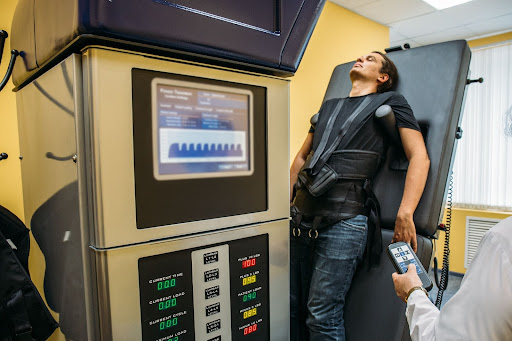When it comes to pain management, physical therapy, and chiropractic care are two complementary modalities that can work together to provide a holistic approach to treatment. While physical therapy focuses on strengthening and rehabilitating the muscles and joints, chiropractic care emphasizes the realignment of the spine to improve nervous system function. Both physical therapy and chiropractic care can be highly effective in treating a wide range of conditions, including back pain, neck pain, joint pain, headaches, sports injuries, and more. While each field has its unique strengths, combining these two approaches can provide even more benefits for patients.
One of the key benefits of combining physical therapy and chiropractic care is that it can help patients achieve faster and more lasting pain relief. While chiropractic adjustments can provide immediate relief from pain and discomfort, physical therapy can help patients build strength and flexibility, reduce inflammation, and improve overall function, which can help prevent the pain from recurring.
Overall, the combination of physical therapy and chiropractic care at Spine Pro Chiropractic can provide patients with a holistic, non-invasive approach to pain management, injury prevention, and overall wellness. By working together, physical therapists and chiropractors can help patients achieve their health goals more effectively and efficiently, leading to a better quality of life and improved overall health.
Understanding Physical Therapy
Physical therapy is a form of treatment that aims to improve physical function and reduce pain through the use of exercise, stretching, and other techniques. Physical therapists are trained to help patients manage pain, improve mobility, and restore strength and function to the body.
One of the key benefits of physical therapy is that it is a non-invasive form of treatment that does not rely on medications or surgeries. Instead, physical therapists use a variety of techniques to help patients manage their pain and improve their quality of life.
Physical therapy can be used to treat a variety of conditions, including:
- Musculoskeletal injuries; such as strains, sprains, and fractures
- Chronic pain conditions; such as arthritis and fibromyalgia
- Neurological conditions; such as stroke and Parkinson’s disease
- Sports injuries; such as concussions and ACL tears
- Post-surgical rehabilitation
Physical therapy typically involves an initial evaluation, during which the therapist will assess the patient’s range of motion, strength, and functional abilities. Based on this evaluation, the therapist will develop a personalized treatment plan that may include exercises, stretches, and other techniques to help the patient achieve their goals.
Physical therapy treatment may involve various techniques, such as:
- Therapeutic exercise: This involves specific exercises designed to improve strength, endurance, flexibility, and balance. The PT may use equipment such as weights, resistance bands, and balance balls to enhance the effects of the exercise.
- Manual therapy: This involves hands-on techniques such as massage, joint mobilization, and manipulation to reduce pain and improve mobility.
- Electrical stimulation: This involves using small electrical currents to stimulate muscles and reduce pain.
- Ultrasound therapy: This involves using high-frequency sound waves to improve blood flow and promote healing.
- Heat and cold therapy: This involves using heat or cold to reduce pain, inflammation, and muscle spasms.
- Education and counseling: This involves teaching patients about proper posture, body mechanics, and other techniques to prevent future injuries and improve their overall health.
Understanding Chiropractic Care
Chiropractic care is a form of treatment that focuses on the musculoskeletal system, particularly the spine. Chiropractors are trained to identify and treat misalignments in the spine, which can cause pain and other symptoms throughout the body.
Chiropractic care typically involves a manual adjustment, during which the chiropractor will use their hands or a special instrument to manipulate the joints in the spine. This manipulation can help improve spinal alignment and reduce pain and other symptoms.
Chiropractic care can be used to treat a variety of conditions, including:
- Back pain
- Neck pain
- Headaches & Migraines
- Whiplash
- Carpal tunnel syndrome
- Sports injuries
- Car accident injuries
- Sciatica and other nerve-related conditions
- Arthritis and other degenerative conditions
- Fibromyalgia and other chronic pain conditions
- Sleep disorders
Like physical therapy, chiropractic care is a non-invasive form of treatment that does not rely on medications or surgeries. However, chiropractic care is more focused on the spine and its role in the body’s overall health and function.
Benefits of Combining Physical Therapy and Chiropractic Care
While physical therapy and chiropractic care are distinct forms of treatment, they can be used together to provide a comprehensive approach to pain management. When combined, physical therapy and chiropractic care can provide the following benefits:
Physical therapy and chiropractic care are two distinct healthcare practices, but they can complement each other when used together. While chiropractic care focuses on diagnosing and treating disorders of the musculoskeletal system, physical therapy aims to restore mobility and function to patients with movement impairments. Combining these two approaches can bring numerous benefits, including better pain relief, faster recovery, and improved long-term outcomes.
Improved Pain Relief
Chiropractic care and physical therapy are both effective in relieving pain, but they use different techniques to achieve this goal. Chiropractors use spinal adjustments to correct misalignments in the spine and improve nerve function. Physical therapists, on the other hand, use exercises, stretches, and other techniques to reduce pain and improve mobility. Combining these two approaches can provide more comprehensive pain relief, especially for patients with chronic pain conditions.
One study published in the Journal of Manipulative and Physiological Therapeutics found that patients with chronic low back pain who received both chiropractic care and physical therapy had better outcomes than those who received either treatment alone. The researchers concluded that combining these two approaches can lead to faster and more effective pain relief.
Faster Recovery
When you are injured or suffering from a medical condition, you want to recover as quickly as possible. Combining chiropractic care and physical therapy can help you achieve this goal. Chiropractic care can help realign the spine, improve nerve function, and reduce inflammation, all of which can speed up the healing process. Physical therapy can help restore strength and mobility to the affected area, reduce scar tissue, and prevent future injuries.
For example, if you have a sports injury, combining chiropractic care and physical therapy can help you recover faster. Chiropractic adjustments can help realign the spine and reduce inflammation, while physical therapy exercises can help strengthen the muscles and improve flexibility. By using these two approaches together, you can recover faster and get back to your normal activities sooner.
Improved Long-Term Outcomes
Combining chiropractic care and physical therapy can also lead to improved long-term outcomes. Chiropractic care can help improve posture, reduce joint wear and tear, and improve overall musculoskeletal health. Physical therapy can help improve strength, flexibility, and balance, which can help prevent future injuries and improve the overall quality of life.
For example, if you have a chronic condition such as arthritis, combining chiropractic care and physical therapy can help you manage your symptoms and improve your overall health. Chiropractic adjustments can help reduce joint inflammation and improve joint mobility, while physical therapy exercises can help improve strength and flexibility. By using these two approaches together, you can improve your overall health and reduce the risk of future injuries or complications.
Improved Functionality
Combining chiropractic care and physical therapy can also help improve your overall functionality. Chiropractic care can help improve joint mobility, reduce pain, and improve nerve function. Physical therapy can help improve strength, flexibility, and balance, which can help you perform your daily activities with greater ease and comfort.
For example, if you have a condition such as sciatica, combining chiropractic care and physical therapy can help you improve your overall functionality. Chiropractic adjustments can help reduce pressure on the sciatic nerve, while physical therapy exercises can help improve strength and flexibility in the affected area. By using these two approaches together, you can improve your overall functionality and quality of life.
Physical Therapy & Chiropractic Care
Physical therapy and Chiropractic care at Spine Pro Chiropractic are two valuable forms of treatment for a variety of musculoskeletal conditions. While they have some key differences, both approaches can be effective in reducing pain, improving mobility and function, and helping patients achieve optimal health and wellness.
Ultimately, the best approach for each patient will depend on their individual needs and preferences and should be made in consultation with a healthcare professional. By seeking out qualified practitioners and taking an integrative approach at Spine Pro Chiropractic, patients can maximize their chances of achieving optimal outcomes and living healthy, active lives.




